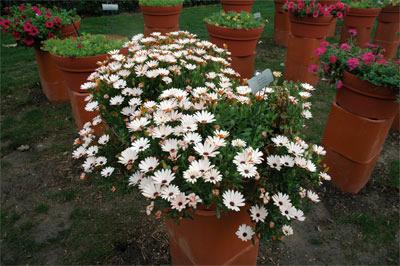
Plant of the Month: Osteospermum Symphony
Osteospermum x hybrid ‘Symphony’ series
AT A GLANCE
Latin name: Osteospermum x hybrid ‘Symphony’ series
Common name: Osteospermum
Flowers: Brightly colored daisies
Foliage: Mounding
Mature height: 10-14”
Hardiness: Annual
Soil: Well-drained
Exposure: Full sun
Water usage: Low
Sources: Local nurseries
There are plants we all love that will never be summer-long survivors. What’s important to remember is that it’s all about expectations. As long as we gardeners know that a certain plant is going to fade with the high heat or die with the first hard frost, we can make educated purchases. So when should we spend money at the local garden center on a plant that isn’t going to live all summer long? My belief is that there are two times a year in Texas when we need what I call “Garden Bouquets.” These are plants that literally look like a bouquet of cut flowers that we purchase to jazz up our combination containers. The first time of year hits in mid- to late February with the first 70-degree day. It’s warm enough to kick spring fever into high gear, but not late enough in the year to get past our average last frost date. Then in fall, we have that period in late September when we need something more than pansies to liven up our garden containers.
If you think I’m crazy and wonder where I’m going with this article, then think of the times you have purchased petunias, nemesia, calibrachoa, geraniums, or even chrysanthemums. All of these are really temporary fillers for our Texas gardens. In addition to looking for the toughest “FlameProof” plants at the Dallas Arboretum trial gardens, I also look for the best “Garden Bouquet” types to use. If I’m going to spend money on temporary filler for my containers, it better be the best variety I can find. My rule of thumb for any of these plants is that they have to give me at least eight weeks of non-stop color before they perish.
One genus I’ve recently added to my approved list of “temporaries” is Osteospermum, which, unfortunately, doesn’t have a good common name. With its bright-colored daisy flowers, this genus has taken the nation by storm. Native to South Africa and planted all over California, it relishes cool, dry weather (not something commonly associated with Texas). I’ve been on the search to find the best cultivar of this genus. The winner for the last two years has been the ‘Symphony’ series from Proven Winners. We have liked them best because of their vigorous growth, large flowers, and tolerance to cold. What makes them stand out the most is the fact that every year they still look good right up until temperatures finally soar into the 100s. At that point they quickly fade away.
The ‘Symphony’ series comes in five colors: Lemon, Melon, Orange, Peach, and Vanilla. My personal favorites have been Lemon and Orange, since their super-bright colors make them visible from across the yard. As you have come to know, I like bold colors, but the pastels are beautiful as well. Each plant will get 10 to 14 inches tall and spread about 18 inches. They are best used in early spring or fall mixed containers. Their South African heritage gives them great tolerance to drought, so you won’t need to water them every day. Wait until they wilt before giving them a good soaking. If you over-water them, they will rot and quickly fade away.
I recommend using these plants in containers to show off their trailing habit. You can plant them in early fall if you can still find them at that time of year. They will overwinter and flower if you live south of Dallas. I have had them survive short spells of low 20s. If you buy them during the fervor of spring buying in February, they will make it through early frosts right up until late June. Over three months of flower — not bad for a plant that is temporary filler!
